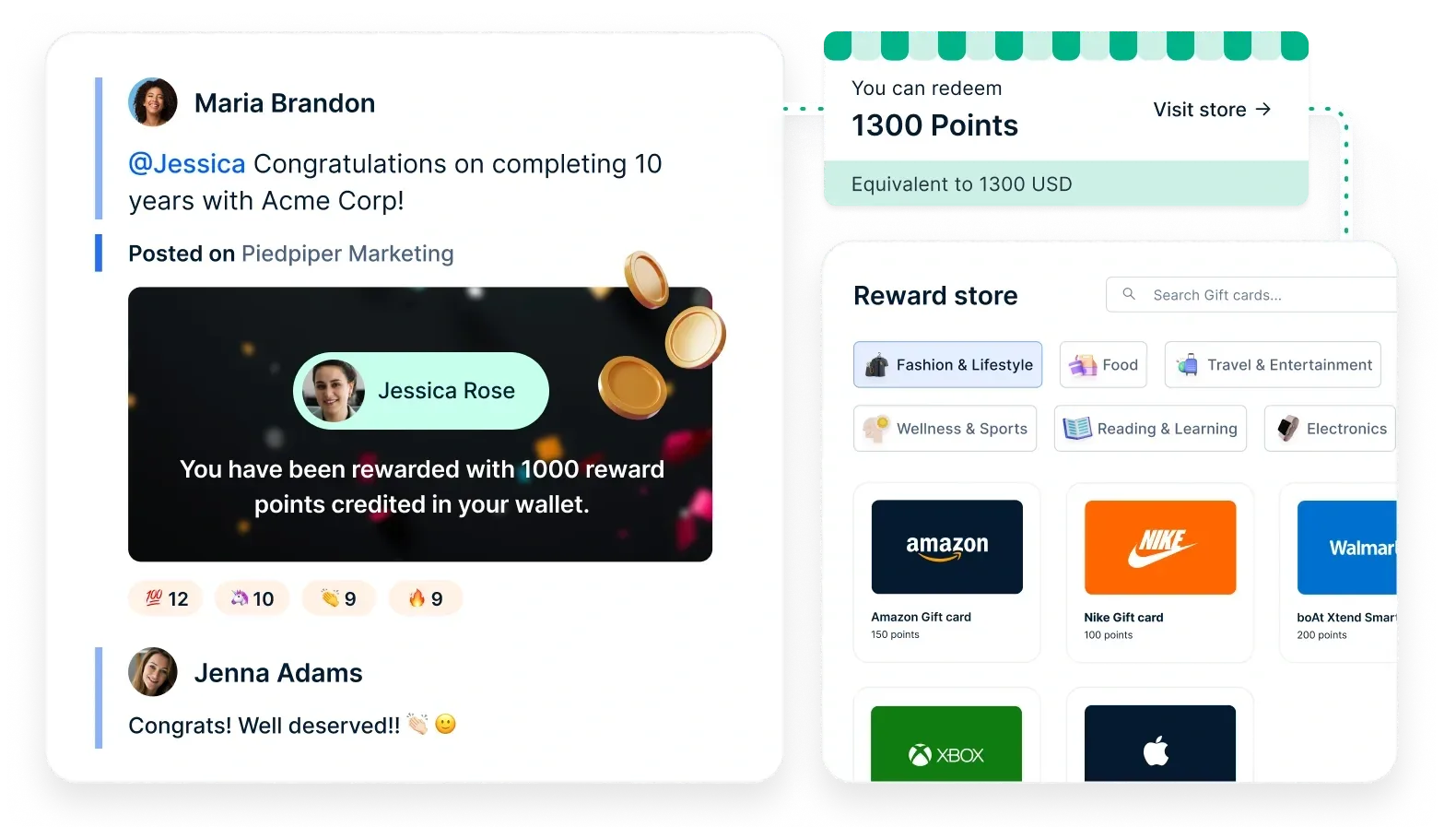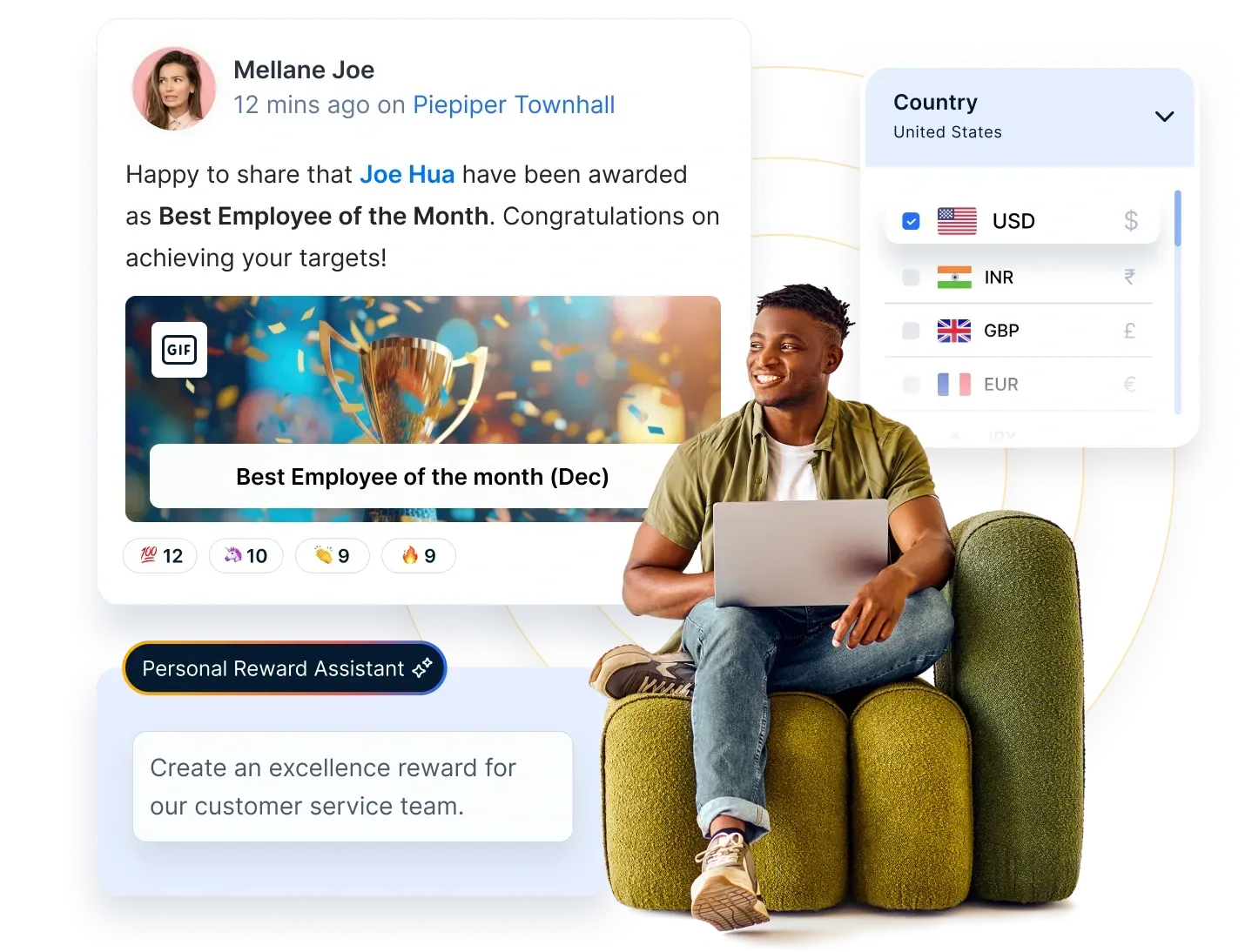Mitarbeiterengagement im Einzelhandel: 10 Strategien, um die Regale zu füllen und die Stimmung zu verbessern
Retail employees are crucial in shaping customer experiences and driving sales. However, high turnover and disengagement remain significant challenges in the retail sector. This blog explores engaging retail employees, enhancing motivation, and building a committed workforce.
Auf dieser Seite
- The importance of employee engagement in the retail industry
- Common challenges in the retail industry
- 10 Strategies for engaging and motivating retail employees
- 5 Companies with amazing retail employee engagement strategies and lessons to learn from them
- Elevate Engagement for Your Consumer Goods & Retail Workforce with Empuls
- How Empuls transforms employee engagement:
- Schlussfolgerung
Retail employees are the driving force behind any successful store. As the first point of contact for customers, their performance directly impacts customer satisfaction, sales, and brand reputation. Prioritizing employee engagement in the retail industry is essential, as motivated employees are 31% more productive and contribute to a 37% increase in sales, according to a study by the World Economic Forum.
Since front-line retail employees represent the brand and influence overall shopping experiences, fostering retail employee engagement should be a top priority. Research from the University of Oxford highlights that motivated retail employees are likelier to go the extra mile, provide exceptional customer service, and stay committed to their roles.
However, the retail sector faces one of the highest employee turnover rates, often exceeding 60% in the U.S, with some estimates reaching 100% for part-time retail workers. To combat this challenge, businesses must focus on how to engage retail employees through recognition programs, career development, and continuous feedback.
In this blog, we’ll explore effective strategies to boost employee motivation in the retail sector, ensuring your workforce remains engaged, productive, and dedicated to driving business success. Whether you're a retail manager or an employee, you’ll find valuable insights to create a thriving and motivated team.
The importance of employee engagement in the retail industry
Employee engagement in the retail industry is critical for delivering exceptional customer experiences and driving business success. Engaged employees are more motivated, productive, and committed to their roles, leading to higher sales, better customer interactions, and improved team morale.
Prioritizing retail employee engagement helps reduce turnover, enhance operational efficiency, and create a positive workplace culture. Effective strategies such as recognition programs, career development opportunities, and regular feedback can significantly boost employee motivation in the retail sector.
Investing in employee engagement in the retail sector ensures a more satisfied workforce, stronger brand loyalty, and long-term business growth.
Common challenges in the retail industry
The retail industry faces several workforce challenges impacting business performance and employee satisfaction. From long working hours to high turnover rates, these issues can lower employee motivation in the retail sector and affect customer experience. A strong retail employee engagement strategy is essential to motivate teams, reduce attrition, and improve workplace productivity.
1. Demanding & long hours
Retail employees work in fast-paced, high-pressure environments, often standing for long hours while handling customer inquiries, stocking shelves, and managing transactions. The physical and mental strain can lead to burnout and disengagement. A well-structured employee engagement in the retail industry approach, including recognition programs, wellness initiatives, and flexible scheduling, can help motivate employees and improve retention.
2. Communication challenges
With retail operations spanning multiple locations, ensuring consistent training, clear communication, and seamless team coordination is a significant challenge. Frontline employees may feel disconnected from leadership, impacting productivity and morale. Investing in digital communication tools, regular check-ins, and structured feedback loops fosters retail employee engagement, keeping staff informed, aligned, and motivated.
3. High turnover rates
The retail industry is known for high employee turnover, driven by seasonal hiring, temporary contracts, and a lack of career growth opportunities. Constantly replacing employees affects team stability, training costs, and customer service quality.
Creating a culture of recognition, growth opportunities, and incentives can boost employee motivation in the retail sector, leading to a more committed and engaged workforce.
4. Customer expectations and service pressure
Retail employees must handle diverse customer needs, complaints, and expectations daily, requiring patience, problem-solving, and strong interpersonal skills.
Employees may struggle to maintain high service standards without proper support and motivation. Continuous training, performance-based rewards, and a positive work culture help employees feel valued, engaged, and motivated to deliver excellent customer experiences.

Empower Your Retail Employees with Recognition & Feedback
Retail success starts with engaged employees. Celebrate achievements, gather real-time insights, and create a motivated workforce with Empuls. Strengthen team connections and boost retention with a seamless engagement platform.
10 Strategies for engaging and motivating retail employees

Motivating retail employees is crucial for providing excellent customer service, improving sales, and fostering a positive work environment. Here are some tried-and-true retail employee engagement strategies to motivate employees and ensure they remain engaged and productive.
1. Gamifizierte Anreize
Turn everyday tasks into a game or competition. Gamification leverages the natural desire for competition, achievement, and recognition. By setting up sales competitions, leaderboards, or rewards programs based on performance, employers can engage and motivate retail employees in a fun and interactive way.
Starbucks implemented the “Starbucks Rewards” program not only for customers but also for employees. Baristas can earn "stars" for up-selling products, displaying exemplary customer service, or completing training modules.
Durch das Sammeln von Sternen können die Mitarbeiter bestimmte Stufen erreichen, was zu Belohnungen und Anerkennung führt, die sowohl intrinsisch als auch greifbar sein können.
2. Kontinuierliches Lernen und Entwicklungsmöglichkeiten
Bieten Sie Ihren Mitarbeitern immer wieder die Möglichkeit, innerhalb des Unternehmens zu lernen, zu wachsen und sich weiterzuentwickeln. Dies kann durch Schulungen, Workshops oder sogar Kurse geschehen, die ihnen helfen, ihre Fähigkeiten zu verfeinern oder neue zu erlernen.
Dies kommt dem Unternehmen in Form von besser qualifizierten Arbeitskräften zugute und steigert die Moral und Motivation der Mitarbeiter, da sie sich wertgeschätzt fühlen und einen klaren Weg zur Weiterentwicklung innerhalb des Unternehmens sehen.
Apple is well-known for its extensive employee training programs. New retail employees, or “Specialists”, start with a multi-day training where they learn about the company, its products, and the importance of customer service.
Apple beschränkt sich nicht nur auf Produkt- oder Verkaufsschulungen, sondern konzentriert sich darauf, die Kommunikations- und Problemlösungskompetenzen seiner Mitarbeiter zu verbessern, um sicherzustellen, dass sie mit verschiedenen Kundenszenarien umgehen können. Dieser Ansatz des kontinuierlichen Lernens trägt dazu bei, dass sich die Mitarbeiter wertgeschätzt und vorbereitet fühlen, was zu einer höheren Motivation und Loyalität gegenüber der Marke führt.
3. Rabatt- und Sozialleistungsprogramme für Mitarbeiter
Einzelhändler können ihren Mitarbeitern das Gefühl geben, etwas Besonderes zu sein und geschätzt zu werden, indem sie ihnen Preisnachlässe auf Produkte oder exklusive Leistungsprogramme anbieten. Dies motiviert die Mitarbeiter, da sie ein persönliches Interesse an den Produkten haben, die sie verkaufen, und fördert eine tiefere Verbindung und Loyalität zur Marke.
The Gap and its subsidiaries, like Banana Republic and Old Navy, offer employees significant discounts on store merchandise. This kind of benefit incentivizes employees and makes them brand ambassadors, as they often wear or use the products they sell, building a more authentic connection with customers.
4. Offenes Feedback und integrative Entscheidungsfindung
Die Mitarbeiter kennen die Gegebenheiten vor Ort oft aus erster Hand und können wertvolle Einblicke in den Betrieb, die Kundenwünsche und mögliche Verbesserungen geben.
Durch die Schaffung eines Umfelds, in dem die Mitarbeiter das Gefühl haben, dass ihr Feedback geschätzt wird und sie Einfluss auf Entscheidungen nehmen können, können Einzelhändler die Motivation steigern und ein Gefühl der Eigenverantwortung unter den Mitarbeitern kultivieren.
Nordstrom, a renowned name in the retail sector, has always upheld a culture of open communication. They encourage employees to share feedback and ideas regardless of their rank or role.
Dies hat zu verschiedenen betrieblichen Verbesserungen geführt und eine Kultur gefördert, in der die Mitarbeiter das Gefühl haben, dass sie wirklich am Erfolg des Unternehmens beteiligt sind.
5. Peer-to-Peer-Anerkennungsprogramme
Über die Anerkennung von oben hinaus kann die Möglichkeit, dass sich Kollegen gegenseitig anerkennen und feiern, das Gefühl der Kameradschaft und Motivation fördern. Die Mitarbeiter können ihre Kollegen für den "Mitarbeiter der Woche/des Monats" nominieren oder ein Punktesystem verwenden, bei dem sich die Kollegen gegenseitig Punkte für Teamarbeit, hervorragenden Kundenservice oder innovative Ideen geben können. Diese Punkte können später gegen Belohnungen eingelöst werden.
Empuls makes peer-to-peer recognition effortless by providing a seamless platform where employees can appreciate each other in real-time. With Empuls, teams can give recognition badges, share appreciation messages, and award points that contribute to a positive work culture.
This helps employees feel valued by leadership and their colleagues, reinforcing teamwork and boosting morale. The platform’s integration with workplace tools ensures that recognition becomes a natural part of daily interactions, making appreciation more frequent and meaningful.
6. Kreative Pausenräume
Die Umgestaltung des traditionellen Pausenraums in einen entspannenderen und ansprechenderen Raum kann ein einzigartiger Motivator sein. Erwägen Sie die Einführung von Elementen wie bequemen Sitzgelegenheiten, Pflanzen, Brettspielen oder sogar einer kleinen Bibliothek.
Die Idee ist, den Mitarbeitern eine echte geistige Pause zu gönnen und sie für den Rest ihrer Schicht zu erholen. Dies zeigt, dass man sich um ihr Wohlbefinden kümmert, und kann auch die Arbeitsmoral und Produktivität steigern.
LUSH believes in the power of a comfortable and engaging workspace. Many of their retail locations have revamped traditional break rooms into spaces that reflect the brand’s fun and ethical identity.
Mit leuchtenden Farben, bequemen Sitzgelegenheiten und sogar etwas "Spiel und Spaß" können die Mitarbeiter abschalten, sich erfrischen und mit neuer Energie an die Arbeit gehen.
7. Cross-Training-Möglichkeiten
Ermöglichen Sie es Ihren Mitarbeitern, Aufgaben zu übernehmen, die über ihre eigentliche Tätigkeit hinausgehen. Indem Sie eine Kassiererin in den Lagerraum oder einen Verkäufer in die visuelle Verkaufsförderung einführen, erweitern Sie ihre Fähigkeiten und durchbrechen die Monotonie ihrer täglichen Arbeit.
Diese Abwechslung kann ihre Leidenschaft für den Einzelhandel neu entfachen, ihnen ein breiteres Verständnis für das Geschäft vermitteln und potenzielle Aufstiegsmöglichkeiten bieten.
IKEA often rotates its employees through different departments. This approach ensures that staff members understand the company's operations comprehensively.
Die Mitarbeiter wissen dies zu schätzen, denn es bringt Abwechslung in ihre Aufgaben und verschafft ihnen ein breiteres Spektrum an Fähigkeiten, was ihre Tätigkeit dynamischer und erfüllender macht.
8. Programme für persönliches Wachstum und Wellness
Da sich das Wohlbefinden eines Mitarbeiters direkt auf seine Leistung und Motivation auswirkt, sollten Sie Programme anbieten, die sich auf die persönliche Entwicklung und das Wohlbefinden konzentrieren. Das kann von Workshops zur Stressbewältigung über Yogakurse nach der Schicht bis hin zur Bereitstellung von Ressourcen für die Finanzplanung reichen.
Indem sie sich um das ganzheitliche Wohlbefinden ihrer Mitarbeiter kümmern, können Einzelhändler eine stärkere Loyalität und Motivation fördern.
Patagonia, an outdoor clothing retailer, offers its employees unique benefits that underscore its commitment to well-being and personal growth. Among these are yoga classes, an on-site organic cafe, and even opportunities to take paid time off to volunteer.
Die Konzentration auf das Wohlergehen der Mitarbeiter hat zu einer motivierten Belegschaft geführt, die mit den Werten des Unternehmens im Einklang steht.
Wellness programs do more than support employees—they build engagement and loyalty. Empuls helps retailers create holistic wellness initiatives, from financial wellness resources to mental health support and fitness challenges. With seamless integration and automated incentives, Empuls makes wellness a core part of company culture, driving motivation, productivity, and retention.
9. Belohnungen durch "Mystery Shopper"-Feedback
Führen Sie ein "Mystery Shopper"-Programm ein, bei dem die Mitarbeiter nicht wissen, wann sie einem geheimen Bewerter dienen könnten. Wenn die Bewertungen abgeschlossen sind, sollten Sie sich nicht nur auf verbesserungswürdige Bereiche konzentrieren, sondern auch Belohnungen für Mitarbeiter oder Teams anbieten, die bei diesen Bewertungen besonders gut abschneiden.
Die Erwartung positiver Anerkennung durch eine unbekannte Bewertung kann Mitarbeiter dazu motivieren, konstant ihr Bestes zu geben.
The British international sandwich shop chain, Pret A Manger, uses mystery shoppers to visit each store weekly. If a store receives an outstanding evaluation, every employee in that store gets a bonus. This approach encourages consistent excellent service and fosters a team spirit, as everyone benefits from the collective effort.
10. Durchführung von "Passionsprojekten"
Geben Sie Ihren Mitarbeitern jeden Monat ein paar Stunden Zeit, um an einem einzelhandelsbezogenen Projekt ihrer Wahl zu arbeiten. Das kann die Gestaltung einer neuen Schaufensterdekoration sein, die Organisation einer Veranstaltung für die Gemeinde oder sogar die Entwicklung einer neuen Marketingkampagne für die Filiale.
Solche Projekte geben den Mitarbeitern die Möglichkeit, ihre Kreativität zu entfalten, sich zugehörig zu fühlen und direkt zum Ambiente des Geschäfts oder zum Ruf der Gemeinde beizutragen.
While not a traditional retail company, Google's famous "20% time" policy allowed employees to spend one day a week working on a project unrelated to their main job.
Diese Politik hat einige der besten Produkte des Unternehmens hervorgebracht, wie Gmail. Einzelhändler können einen ähnlichen Ansatz in kleinerem Rahmen verfolgen, indem sie ihre Mitarbeiter an Projekten arbeiten lassen, die ihnen am Herzen liegen und die dem Geschäft zugutekommen können.
Diese einzigartigen Strategien konzentrieren sich auf die oft übersehenen, sanfteren Aspekte der Motivation und betonen den gegenseitigen Respekt unter den Kollegen und echte Pausen zur Erholung.
Durch Investitionen in diese Maßnahmen können Einzelhändler ein ganzheitlicheres Modell der Mitarbeitermotivation erreichen, das die Arbeitszufriedenheit und die Leistung verbessert.

Build a Thriving Retail Team with Empuls
Keep your employees motivated with meaningful rewards, actionable feedback, and a social intranet that fosters connection. Elevate engagement and reduce turnover today.
5 Companies with amazing retail employee engagement strategies and lessons to learn from them
Entdecken Sie fünf praktische und bewährte Strategien von einigen der besten Unternehmen zur Förderung des Mitarbeiterengagements im Einzelhandel. Von der Verbesserung der Kommunikation und Anerkennung bis hin zur Schaffung von Wachstumschancen und Work-Life-Balance - erfahren Sie, wie Sie in Ihrem Einzelhandelsunternehmen eine motiviertere und produktivere Belegschaft schaffen können.
1. Arby's: Sorge um das Glück der Mitarbeiter
Arby’s is a fast-food restaurant chain founded in 1964. During the early 2010s, Arby’s restaurant empire was drowning. Employees were quitting, customers weren’t returning, and the business vitals weren’t looking good.
Paul Brown was hired by Roark Capital in 2013 as the company's CEO despite having no experience in the restaurant business. It turns out that this is the exact reason why Brown was able to save Arby.
Since he didn’t have all the answers, he turned to the people who might — the employees. He rounded up the oldest employees and asked them one question: what would you do if you were me?
Auf diese Frage gab es viele Antworten, die Brown und seinem Team halfen, zwei dringende Probleme zu entdecken:
- Die Mitarbeiter waren nicht richtig geschult. Das bedeutete, dass sie nicht über die richtigen Informationen verfügten, die ihnen helfen würden, ihre Kunden effektiv zu bedienen.
- Arby's hat nicht genug mit ihnen kommuniziert, so dass sich die Mitarbeiter unterbewertet fühlten.
Beide oben genannten Gründe hinderten die Kunden von Arby's daran, den Wert zu erhalten, den sie suchten, und beeinträchtigten gleichzeitig die Work-Life-Balance der Mitarbeiter. Folglich ging das Engagement der Mitarbeiter zurück, was sich auf die Gesamtleistung der Marke auswirkte.
Arby's hat ein Marken-Champion-Programm ins Leben gerufen, das den Mitarbeitern helfen soll, die Ziele von Arby's zu verstehen und die Möglichkeit zu erhalten, ihre eigenen zu verstehen.
Dieses jährliche Mitarbeiterschulungsprogramm stattet die Mitarbeiter mit den richtigen Fähigkeiten und Kenntnissen aus, um ihren Kunden einen Mehrwert zu bieten. Außerdem hilft es Arby's, die persönlichen und beruflichen Ziele seiner Mitarbeiter zu verstehen.
Infolgedessen konnten sich die Mitarbeiter und Arby's gegenseitig verstehen, was zu einer besseren Vereinbarkeit von Beruf und Familie führte.
Since its inception in 2013, nearly 400,000 team members have been trained through this program which kept the company profitably growing. Brown, with help from his employees, changed the tides which led to a consistent increase in Arby’s revenues since 2016.
The key lesson for retail business owners is to care about their most valuable asset — employees. It involves helping them understand your business goals, investing in them through dedicated training programs, recognizing their goals, and actively listening to feedback.
Gathering employee feedback can be challenging when you are short on time and human resources. Paul Brown himself traveled to 50+ locations to talk with his employees! Although such interactions are valuable, not every retailer can do that.
A better alternative here is to create detailed questionnaires using a form builder and send them to your employees via email or text. This will take minutes for you to set up, and will get feedback from all your employees in one place.
With the relevant data, you can take the proper steps to make your employees feel valued and promote a healthy work-life balance in the short and long run.
2. Nordstrom: Mythisches Mitarbeiterhandbuch
Customer service is a crucial aspect of retail business. Great customer service keeps customers returning with their friends and bad ones drive them away. Retail businesses, therefore, go far and wide to ensure that their in-store employees are treating their customers properly.
It is not uncommon for retailers to round up their new hires and explain to them the what's, whys, and hows of interacting with customers. Although this works for the major part, this strategy is flawed due to the following reasons:
- Dadurch verlängert sich der Prozess der Mitarbeiterschulung.
- Der größte Teil dieser Phase der Mitarbeiterschulung besteht aus allgemeinen guten Ratschlägen, die die Mitarbeiter vielleicht gar nicht brauchen.
- Die Interaktionen zwischen Mitarbeitern und Kunden klingen unauthentisch, da sich erstere fast an ein Drehbuch halten.
Die oben genannten Herausforderungen führen oft zu einem schlechten Kundenservice - das Gegenteil der beabsichtigten Wirkung.
Nordstrom, a luxury fashion retail chain that is known for great customer service, might have the answer.
Surprisingly, new employees don’t receive a list of strict guidelines to interact with customers effectively whenever they join the team. Instead, they are handed a 5” x 8” gray card that contains only one rule of Nordstrom for their employees:
Das kurze Mitarbeiterhandbuch hilft Nordstrom, die Schulungskosten zu senken, und gibt den Mitarbeitern die Möglichkeit, die Interaktion mit den Kunden nach bestem Wissen und Gewissen zu gestalten. Dadurch wird auch die Kultur des Mikromanagements beseitigt, was zu einer insgesamt gesunden Arbeitskultur führt.
To sweeten the deal, Nordstrom gives employees a discount of 20% or 33% on a flat rate based on their designation. During festive seasons, the discount often increases by 10-20%, based on what the store managers decide.
Zwar kann nicht jedes Einzelhandelsunternehmen sein Mitarbeiterhandbuch auf eine einfache Regel reduzieren, aber Sie können es auf jeden Fall erheblich verkürzen, indem Sie Ihren Mitarbeitern vertrauen, dass sie ihre Arbeit erledigen.
Ein solcher Schritt setzt einfache, aber klare Erwartungen für Ihre Mitarbeiter und macht Ihre internen Verfahren einheitlich, wodurch das Engagement und die Motivation der Mitarbeiter verbessert werden.
3. Wegmans: Investitionen in die Mitarbeiter
Wir haben oben zwei Dinge erwähnt, die Einzelhandelsunternehmen berücksichtigen sollten: Mitarbeiter sind ein Aktivposten und man sollte in sie investieren.
Wegmans, an American supermarket chain, recognized the importance of investing in employees. The store managers at Wegmans adopted a bias for action and have successfully fostered a nurturing workplace.
Darüber hinaus investiert Wegmans jährlich mehr als 50 Millionen Dollar in die Aus- und Weiterbildung seiner Mitarbeiter, unabhängig davon, ob die zukünftigen Karriereziele der Mitarbeiter mit den Geschäftszielen von Wegman übereinstimmen.
According to the 2021 Global Employee Engagement Study by Great Place To Work, 90% of Wegmans employees agree that it is a great place to work, compared to the national average of 57%.
An official from Wegmans explained in an interview how important customer satisfaction and retention is for them. To achieve that goal, it was important to put the employees first. They added, “in order to be a great place to shop, we must first be a great place to work.”
Auch wenn es für die meisten Einzelhändler eine Herausforderung sein wird, auf einem solchen Niveau in ihre Mitarbeiter zu investieren, können sie sicherlich die folgenden Praktiken von Wegmans übernehmen:
- Legen Sie Verfahren und Protokolle fest, mit denen die Mitarbeiter vertraut sind: Eine gute Möglichkeit, dies in die Praxis umzusetzen, besteht darin, Ihre Mitarbeiter aufzufordern, kleine Gruppen zu bilden und sich aktiv an der Erstellung dieser Verfahren zu beteiligen.
- Sorgen Sie dafür, dass diese Verfahren für alle einheitlich sind: Die Gleichbehandlung der Mitarbeiter unter Berücksichtigung ihrer Stellung im Unternehmen ist für die Förderung des Teamgeistes von entscheidender Bedeutung. Dadurch wird die Zusammenarbeit innerhalb des Unternehmens verbessert, was das Engagement der Mitarbeiter erhöht.
- Teilen Sie die Erfolge mit Ihrem Team: Egal, ob es sich um eine Umsatzsteigerung, eine Geschäftserweiterung oder ein Arbeitsjubiläum handelt, nutzen Sie diese Momente als Gelegenheit, Ihre Mitarbeiter zusammenzubringen.
- Listen to employees' grievances and act: Employees coming forward with a complaint or a suggestion is excellent as it takes the guesswork out of where you need to invest. Besides, it shows that your team members are willing to help you improve the workplace.
The above methods of investing in employees bring them closer to your brand by increasing their involvement in your store’s success, increasing employee engagement and motivation.
4. Recreational Equipment Inc: Mehr bezahlter Urlaub
Working in retail is challenging. Dealing with multiple customers, working for long hours with small breaks, and ensuring store policies are followed correctly are some of the many challenges that retail employees face daily.
If there is one thing that retail employees want it is more paid leave.
Recreational Equipment Inc. (REI) started by giving two more leaves to its employees than the industry standard to help them “go out and get inspired”. On holidays such as Thanksgiving and Black Friday when retail employees are busy, REI prefers to reward its employees with paid time off.
Recently, REI announced that they will also give paid leave to their employees to vote during the Presidential elections.
This allows employees to maintain a healthy work-life balance and inspires them to respect their employer and colleagues. By putting the employees’ happiness first, REI ranked #4 in the Fortune Best Workplaces in Retail 2020.
More paid leaves will increase employee happiness and morale, directly affecting work performance. A well-rested and rejuvenated employee is likelier to perform better than a tired employee under the same conditions.
Consequently, your employees will remain more engaged at work and will be motivated to deliver the best customer experiences.
Abgesehen davon, dass Sie die Strategie von REI, mehr bezahlten Urlaub zu gewähren, übernehmen, können Sie Ihren Mitarbeitern helfen, sich besser zu erholen:
- Einstellung von mehr Mitarbeitern, um die Arbeitsbelastung der vorhandenen Mitarbeiter zu verringern.
- Einführung von Halbtagen zu bestimmten Zeiten des Jahres.
- Die Dauer der Pausen, die Ihre Mitarbeiter bei der Arbeit einlegen, sollte erhöht werden.
5. Starbucks: Bezahlen mit mehr als Geld
So far, we have shared examples that illustrate how retailers have improved their workplace by caring about their employees' happiness, providing them with the right training, respecting them, and giving them more time off.
Aber es gibt einen Weg, der besser funktioniert als alle anderen - Vergünstigungen.
Just like customer expectations, employee expectations in retail have evolved. Retailers now have to provide more than a steady paycheck and paid time off to ensure employee satisfaction.
Starbucks hat dies verstanden und ist über sich hinausgewachsen, um seinen Mitarbeitern die folgenden Vergünstigungen zu bieten:
- Goodies and discounts: Each shift you can get up to four free drinks and a food item from the menu; every week you can take home a free bag of coffee, Tazo Tea, VIA Ready Brew packets, and a box of 12 K-Cups; and a 30% discount on anything whenever you shop from any Starbucks.
- Free tuition to Arizona State University: Part-time and full-time employees working at standalone Starbucks locations can get a 100% scholarship while pursuing an online bachelor’s degree at Arizona State University. You can choose from over 140 programs.
- Maternity leave: Mothers working at Starbucks stores who clock in over 20 hours/week are eligible to receive six weeks of paid time off. If they are working in Starbucks’ corporate offices, the paid time off is extended to 12 weeks.
- Savings plan for the future: You can start throwing money in Starbucks’ Future Roast 401(k) retirement plan after working for 90 days or more. The best benefit is Starbucks will match the first 5% of your contribution for each pay period!
- Pocket-friendly health benefits: Part-time and full-time employees who log in more than 20 hours/week and have been working for more than 90 days can choose their preferred medical health plan which also covers their dental and vision requirements.
Wenn Mitarbeiter mehr Wertschätzung erfahren als ein bloßes Schulterklopfen, verbessern sich ihr Engagement für die Arbeit, ihre Bindung an das Unternehmen und ihre Motivation bei der Arbeit.
Although not all retailers can match Starbucks in terms of additional perks, they can surely increase their offerings for their employees. For instance, you can offer employee discounts, freebies, maternity leaves, and secure retirement plans.
Elevate Engagement for Your Consumer Goods & Retail Workforce with Empuls

Retail and consumer goods employees thrive on motivation, connection, and recognition. Yet, high turnover and disengagement remain common challenges. Empuls helps bridge this gap by fostering a culture where feedback, rewards, and community-driven engagement come together to create a motivated and loyal workforce.
How Empuls transforms employee engagement:
- ✔ Recognize & reward contributions: Celebrate milestones, achievements, and everyday wins with meaningful and tax-efficient rewards.
- ✔ Turn feedback into action: Gather real-time employee insights through automated surveys and use data-driven decisions to improve workplace experiences.
- ✔ Strengthen team connections: Build a sense of belonging with an interactive social intranet that keeps employees engaged, informed, and connected.
- ✔ Boost retention & performance: Empower employees with recognition programs that enhance motivation and loyalty in a fast-paced retail environment.
From frontline staff to corporate teams, Empuls creates an environment where employees feel valued and engaged—driving organizational performance and satisfaction. Connect with our engagement experts now!
Schlussfolgerung
Die Motivation von Einzelhandelsmitarbeitern ist ein kontinuierlicher Prozess, der eine Kombination von Strategien erfordert, darunter klare Kommunikation, Anerkennung, Schulung, ein positives Arbeitsumfeld und eine wettbewerbsfähige Vergütung.
Wenn Sie in das Wohlbefinden und die Entwicklung Ihrer Mitarbeiter investieren, können Sie ein motiviertes und engagiertes Einzelhandelsteam aufbauen, das zum Erfolg Ihres Unternehmens beiträgt. Denken Sie daran, dass motivierte Mitarbeiter mit größerer Wahrscheinlichkeit einen ausgezeichneten Kundenservice bieten und den Umsatz ankurbeln, was sich letztlich positiv auf Ihr Ergebnis auswirkt.













